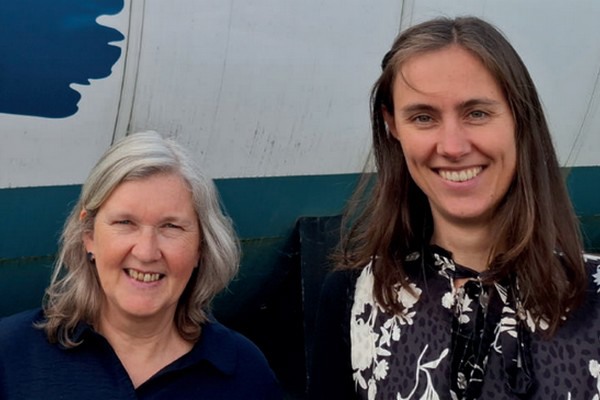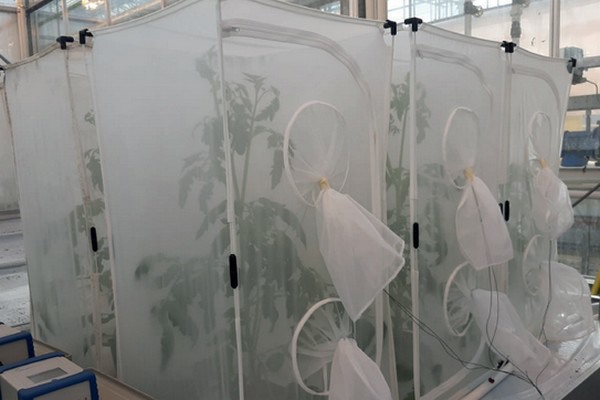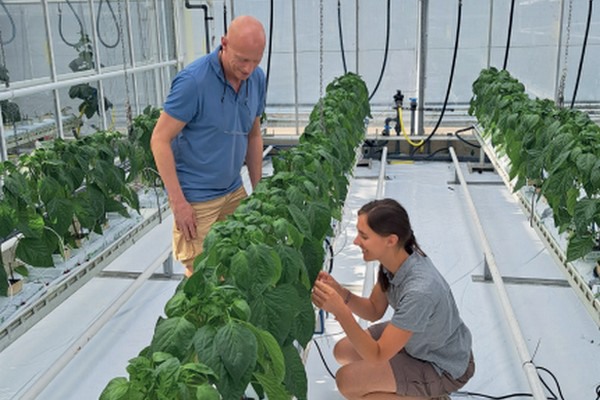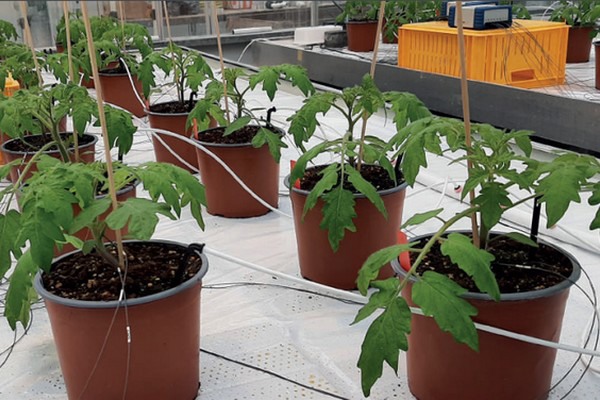Wageningen University & Research (WUR) has investigated early detection of diseases and pests through electrical biosignals. Vivent's biosensors were used for this purpose. In the fourth edition of Horticoop magazine Blad, Alja van der Schuren, Plant Physiology Scientist at Vivent Biosignals, and Kirsten Leiss, Senior Researcher Plant Health at WUR, discuss the research process, the promising results and the opportunities this new method offers growers.

Kirsten Leiss, Senior Researcher Plant Health at WUR and Alja van der Schuren, Plant Physiology Scientist at Vivent Biosignals.
Alja: "Plants use different internal communication mechanisms. For example, a plant can indicate that its roots are under attack or that climate conditions are changing, so that the rest of the plant can prepare itself accordingly. One such communication mechanism is the electrical biosignal. At Vivent, we have developed a method to read that signal. We have created a number of algorithms to read small pieces of information from the electrical signal. This information indicates whether a plant has been attacked by a disease. We then worked with Kirsten to examine pieces of the signal that show an attack by a virus, insect or fungus."
Kirsten: "That's right! In collaboration with the Club of 100, we tested electrophysiological sensors. This makes us the first to examine biosensors for detecting stress caused by invading pests or fungi. This form of stress is also called biotic stress. Plants respond very specifically to insects and fungi. The question is: how can we recognise this response early?"

Testing thrips on tomato plants in closed cages.
Alja: "This can be done by measuring the electrical signals. For this, you need a control group, consisting of plants that are free of all pests and diseases. Then there is a group of test plants, which are plants that are infected. We measure the electrical biosignals of both groups of plants and compare them. It just turns out that making sure plants are infested is not always easy. Occasionally the insects don't do their job, and plants don't get infested. That, of course, remains in nature's hands."
Kirsten: "We have indeed found that it takes a lot of experiments to build a solid dataset. It is and always will be research, and to make good comparisons there has to be a clear difference between the control plants and the test plants. There will always be some data sets that are not usable, so it is essential to experiment a lot."

Alja researches electrical biosignals.
Alja: "From the data we finally collected, we compared the signal of the bud plants with that of the control plants. We also compared the signals in both groups with signals in the periods before, to make sure we are studying the plant in the right phase. The computer then looks for differences between the signals. In doing so, we look at about 700 characteristics of the signal in total, such as the height of the signal or how often the signal moves. The features where the signals are very different between the two groups of plants form the basis of the model we develop."
Kirsten: "For the study, we chose two model plants. For ornamentals, we worked with gerberas, and for fruiting vegetables we used tomato plants. Because we wanted to know if our models work on different organisms, we released a virus, fungus, and an insect on these two plant species. We started with the virus. Unfortunately, we could not infect the plants enough, and the plants showed too few symptoms to build a model with. With the fungus, powdery mildew, another problem occurred. In fact, the control group also turned out to be infected."

In the test with powdery mildew on tomato plants, both the test and control groups turned out to be infected.
Alja: "That was unfortunate! The control plants should also really serve as controls. As soon as an infection is visible there, that data can no longer be used. Otherwise, the model might start seeing the early signs of powdery mildew as a control, and we want to avoid that."
Kirsten: "The insect results were the most promising. For this, we used thrips: small insects that suck out the cells of leaves, allowing air to enter. This gives the leaf a kind of silver sheen. That cosmetic damage is a problem, but so is the virus the thrips spread that weakens the whole plant. The symptoms of this are only visible after 5-6 days, but with the electrical biosignals we could detect the infection after only 2-3 days."
Alja: "That's going to help the grower tremendously. Ideally, you want to detect a disease before it is visible on the plant, and it can spread, so the grower can intervene in time. We are testing all kinds of tactics with different parties in the chain, and it looks promising! For the research with WUR, we used biosensors connected to the plant with a cable. That is fine for an experiment, but in practice a device without cables is desirable. So we recently developed a mini biosensor that runs on batteries. You can place this more easily in different places in the greenhouse."
Kirsten: "Then the information from the plant has to get to the grower as quickly as possible so he can intervene quickly. Is it true that you are already developing something for that too?"
Alja: "We are indeed testing a live dashboard with the first growers. The moment the sensors identify a pest, the grower receives a push message on his phone or computer. The signals come through with only a few minutes delay, so that's almost live data from the greenhouse! With this development, we are moving towards plant-centred growing. We are putting the plant more at the centre of cultivation decision-making. Whereas the generation now gradually retiring often relied on experience, the new generation of growers will work more with new technologies."
Kirsten: "From a researcher's perspective, I completely understand this. I want to be able to read the plant from the inside and understand its language. This is a challenge, but also has a lot of potential. Vivent's electrophysiological sensor not only measures biotic stress, but also abiotic stress, or stress caused by the climate. That combination is unique and offers many opportunities for new research! I am therefore very happy that the Club of 100 has made this research possible."
Alja: "I hope that in the future we can continue this research with the Club of 100 and WUR to eventually grow ever smarter crops!"
The Club of 100 The Club of 100 is a collaboration of various suppliers and trading companies in greenhouse horticulture, including Horticoop. Together with WUR, members of the Club develop knowledge for growers worldwide to contribute to a sustainable, future-proof greenhouse horticulture.
For more information:
Vivent 
[email protected]
www.vivent.nl
WUR
www.wur.nl
